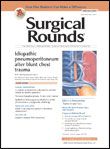Evaluating Prolonged Narcotic Use in Opioid-Naïve Surgical Patients
A study published in BMJ explains the long-term risks of opioid treatment in the postoperative setting.

Clinicians are often concerned about balancing the adequate treatment of acute postsurgical pain against adverse effects, persistent opioid use, and opioids’ contribution to the development of persistent pain. As a result, many surgeons would appreciate access to an assessment tool that could predict prolonged postoperative opioid use.
A study published in the February 2014 issue of BMJ described opioid-naïve patients’ rates of prolonged postoperative opioid use and identified the risk factors for it.
The study authors enrolled 39,140 opioid-naïve patients aged 66 years or older who underwent major elective surgery — including cardiac, intrathoracic, intra-abdominal, and pelvic procedures — at acute care hospitals in Ontario, Canada, between April 2003 and March 2010. Prolonged opioid use was defined as ongoing outpatient prescriptions for opioids for more than 90 days post-surgery.
Approximately half of the patients (49.2%) were discharged from the hospital with an opioid prescription. By 90 days after surgery, only 3.1% continued to receive opioids.
Those with a significantly higher risk of prolonged opioid use were typically younger, earned a lower household income, and had specific comorbidities, such as diabetes, heart failure, and pulmonary disease. Preoperative use of certain drugs — including benzodiazepines, selective serotonin reuptake inhibitors (SSRIs), and angiotensin converting enzyme (ACE) inhibitors — was also associated with prolonged opioid use. The researchers explained that the use of ACE inhibitors may prompt prescribers to avoid non-steroidal anti-inflammatory drugs (NSAIDs) because they may precipitate decompensated heart failure. Among those patients, prescribers may prefer opioids, instead.
The type of surgical procedure was also highly associated with prolonged opioid use. For example, open- and minimally-invasive thoracic procedures were twice as likely to end with prolonged opioid use than open radical prostatectomies. However, open- and minimally-invasive major gynecological procedures were associated with significantly lower risks compared to other surgeries.
Although the study could not prove that all identified associations are causal relations, the findings explained some long-term risks of opioid treatment in the postoperative setting. The results may also help surgeons direct appropriate interventions to specific patient subgroups.

2 Commerce Drive
Cranbury, NJ 08512
All rights reserved.